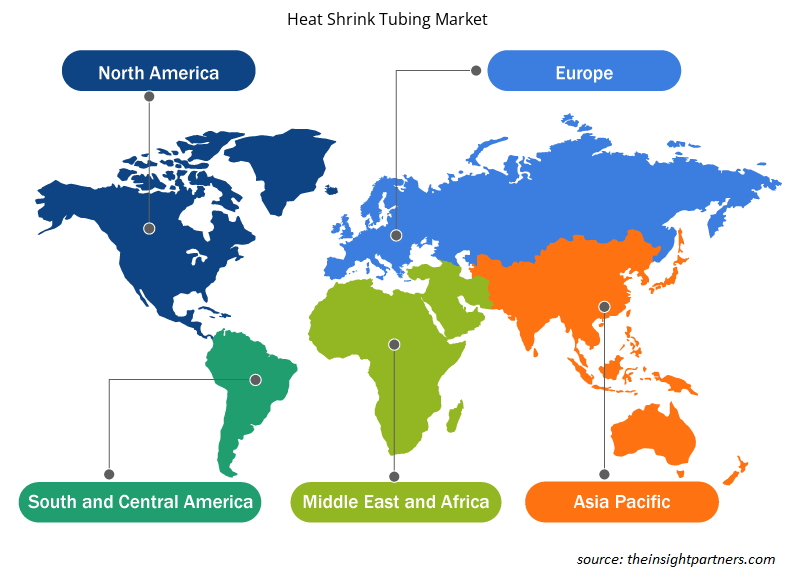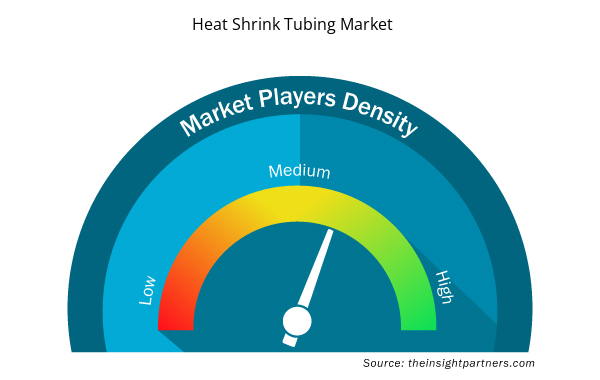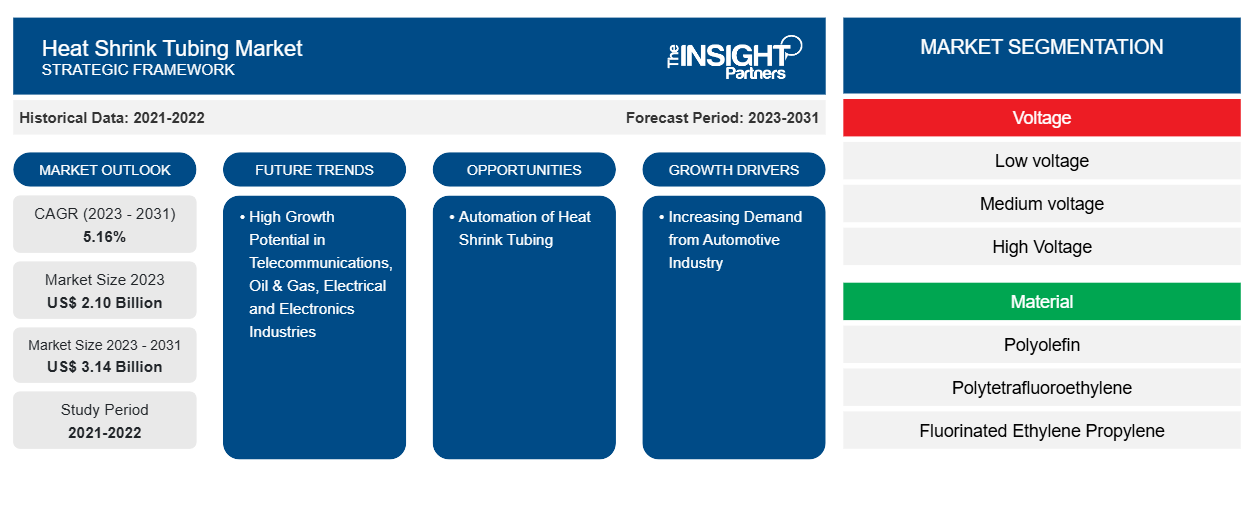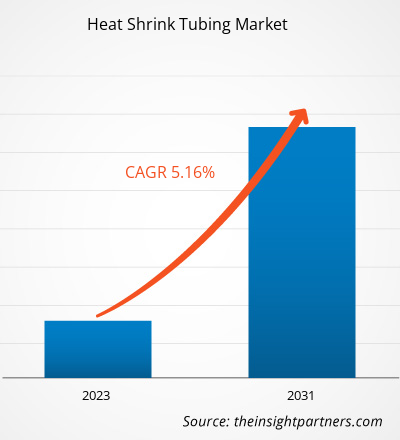Si prevede che il mercato dei tubi termorestringenti raggiungerà i 3,14 miliardi di dollari entro il 2031 dai 2,10 miliardi di dollari del 2023, con un CAGR del 5,16% entro il 2031. La crescente domanda da parte dell'industria automobilistica e le iniziative governative per aggiornare i sistemi di trasmissione ed espandere la distribuzione sono tra i principali fattori che guidano la crescita del mercato. Inoltre, l'elevato potenziale di crescita da settori come l'elettricità e l'elettronica, le telecomunicazioni e il petrolio e il gas offre opportunità di crescita redditizie per il mercato. Si prevede che l'automazione del processo dei tubi termorestringenti emergerà come una tendenza nel mercato durante il 2023-2031.
Analisi di mercato dei tubi termorestringenti
I principali stakeholder nell'ecosistema di mercato includono fornitori di materie prime, produttori di tubi termorestringenti e clienti o utenti finali. Il fornitore di materie prime è uno stakeholder cruciale nell'ecosistema del mercato. Le parti principali dei tubi termorestringenti includono materiali come poliolefina, politetrafluoroetilene, etilene propilene fluorurato, perfluoro alcossi alcano, polivinilidene fluoruro e altri.
Panoramica del mercato dei tubi termorestringenti
I produttori di tubi termorestringenti producono il prodotto in base ai requisiti del settore, compatibile con un'ampia gamma di applicazioni. Le aziende di tubi termorestringenti si stanno concentrando sempre di più sul miglioramento dell'efficienza e dell'autonomia delle batterie potenziando l'infrastruttura di ricarica. La presenza di un gran numero di produttori di tubi termorestringenti sta competendo su larga scala principalmente in base a materiali avanzati e disponibilità di presenza in tutto il mondo. Include 3M, Shenzhen Woer Heat Shrinkable Material Co., Ltd; TE Connectivity e Sumitomo Electric Industries, Ltd tra gli altri attori.
Personalizza questo report in base alle tue esigenze
Riceverai la personalizzazione gratuita di qualsiasi report, comprese parti di questo report, o analisi a livello nazionale, pacchetto dati Excel, oltre a usufruire di grandi offerte e sconti per start-up e università
- Scopri le principali tendenze di mercato in questo rapporto.Questo campione GRATUITO includerà analisi di dati che spaziano dalle tendenze di mercato alle stime e alle previsioni.
Driver e opportunità del mercato dei tubi termorestringenti
Domanda crescente da parte dell'industria automobilistica
Con la crescente tendenza dei veicoli elettrici, la crescente necessità di elettrodomestici cablati sta dando impulso al mercato. Il tubo termorestringente in un veicolo elettrico viene utilizzato in molte applicazioni per la schermatura dei cavi dalla presa di ricarica ai componenti elettrici in tutto il cruscotto del veicolo, il sistema tergicristallo, il sistema di illuminazione, il sistema di chiusura centralizzata, il sistema acustico, il sistema di aria condizionata e così via.
Elevato potenziale di crescita nei settori delle telecomunicazioni, del petrolio e del gas, dell'elettricità e dell'elettronica
I tubi termorestringenti hanno vari usi e sono ampiamente utilizzati nei cavi di rete per telecomunicazioni. I tubi termorestringenti sono utilizzati per proteggere queste connessioni, cavi, conduttori, giunti e terminali dai danni ambientali. Inoltre, l'industria petrolifera e del gas affronta gli effetti e le condizioni ambientali più difficili. Calore estremo, corrosione, pressione e altri fattori influenzano le apparecchiature utilizzate nell'industria petrolifera e del gas. I tubi termorestringenti assicurano che le apparecchiature forniscano prestazioni costanti e affidabili. Pertanto, la domanda di tubi termorestringenti nei settori delle telecomunicazioni, petrolifero e del gas e nei settori elettrico ed elettronico offre ampie opportunità di crescita del mercato.sures the equipment delivers consistent and reliable performance. Thus, the demand for heat shrink tubing across telecommunications, oil & gas, and electrical & electronics industries provides ample opportunities for market growth.
Analisi della segmentazione del rapporto di mercato sui tubi termorestringenti
I segmenti chiave che hanno contribuito alla derivazione dell'analisi di mercato sono tensione, materiale e utente finale.
- In base alla tensione, il mercato è suddiviso in Bassa tensione (inferiore a 5 kV), Media tensione (5-35 kV) e Alta tensione (superiore a 35 kV). Il segmento della bassa tensione (inferiore a 5 KV) ha detenuto una quota di mercato maggiore nel 2023.
- In base al materiale, il mercato globale dei tubi termorestringenti è suddiviso in poliolefina, politetrafluoroetilene, etilene propilene fluorurato , perfluoro alcossi alcano, polivinilidenfluoruro e altri. Il segmento delle poliolefine ha detenuto una quota di mercato maggiore nel 2023.
- A seconda dell'utente finale, il mercato globale è suddiviso in Energia, Servizi di pubblica utilità, Energia elettrica, Infrastruttura/Costruzione di edifici, Industriale, Telecomunicazioni, Automotive, Aerospaziale, Difesa, Trasporto pubblico e mobilità, Medicina, Petrolchimica e Minerario. Il segmento dei servizi di pubblica utilità ha detenuto una quota di mercato maggiore nel 2023.
Analisi della quota di mercato dei tubi termorestringenti per area geografica
L'ambito del rapporto di mercato sui tubi termorestringenti comprende Nord America (Stati Uniti, Canada e Messico), Europa (Spagna, Regno Unito, Germania, Francia, Italia e resto d'Europa), Asia Pacifico (Corea del Sud, Cina, India, Giappone, Australia e resto dell'Asia Pacifico), Medio Oriente e Africa (Sudafrica, Arabia Saudita, Emirati Arabi Uniti e resto del Medio Oriente e Africa) e Sud e Centro America (Brasile, Argentina e resto del Sud e Centro America). In termini di fatturato, l'APAC ha dominato la quota di mercato dei tubi termorestringenti nel 2023. Il Nord America è il secondo maggiore contributore al mercato globale dei tubi termorestringenti, seguito dall'Europa.
Approfondimenti regionali sul mercato dei tubi termorestringenti
Le tendenze regionali e i fattori che influenzano il mercato dei tubi termorestringenti durante il periodo di previsione sono stati ampiamente spiegati dagli analisti di Insight Partners. Questa sezione discute anche i segmenti e la geografia del mercato dei tubi termorestringenti in Nord America, Europa, Asia Pacifico, Medio Oriente e Africa e America centrale e meridionale.

- Ottieni i dati specifici regionali per il mercato dei tubi termorestringenti
Ambito del rapporto di mercato sui tubi termorestringenti
| Attributo del report | Dettagli |
|---|---|
| Dimensioni del mercato nel 2023 | 2,10 miliardi di dollari USA |
| Dimensioni del mercato entro il 2031 | 3,14 miliardi di dollari USA |
| CAGR globale (2023-2031) | 5,16% |
| Dati storici | 2021-2022 |
| Periodo di previsione | 2023-2031 |
| Segmenti coperti | Per voltaggio
|
| Regioni e Paesi coperti | America del Nord
|
| Leader di mercato e profili aziendali chiave |
|
Densità dei protagonisti del mercato dei tubi termorestringenti: comprendere il suo impatto sulle dinamiche aziendali
Il mercato dei tubi termorestringenti sta crescendo rapidamente, spinto dalla crescente domanda degli utenti finali dovuta a fattori quali l'evoluzione delle preferenze dei consumatori, i progressi tecnologici e una maggiore consapevolezza dei vantaggi del prodotto. Con l'aumento della domanda, le aziende stanno ampliando le loro offerte, innovando per soddisfare le esigenze dei consumatori e capitalizzando sulle tendenze emergenti, il che alimenta ulteriormente la crescita del mercato.
La densità degli operatori di mercato si riferisce alla distribuzione di aziende o società che operano in un particolare mercato o settore. Indica quanti concorrenti (operatori di mercato) sono presenti in un dato spazio di mercato in relazione alle sue dimensioni o al valore di mercato totale.
Le principali aziende che operano nel mercato dei tubi termorestringenti sono:
- HellermannTyton
- Azienda: Sumitomo Electric Industries, Ltd.
- Associazione Molex LLC
- 3 milioni
- Shenzhen Woer Heat - Shrinkable Material Co., Ltd
- Shanghai Changyuan Electronic Material Co., Ltd
Disclaimer : le aziende elencate sopra non sono classificate secondo un ordine particolare.

- Ottieni una panoramica dei principali attori del mercato dei tubi termorestringenti
Notizie e sviluppi recenti sul mercato dei tubi termorestringenti
Il mercato viene valutato raccogliendo dati qualitativi e quantitativi dopo la ricerca primaria e secondaria, che include importanti pubblicazioni aziendali, dati associativi e database. Di seguito è riportato un elenco degli sviluppi nel mercato per innovazioni, espansione aziendale e strategie:
- Nel marzo 2024, Junkosha, specialista dei materiali e pioniere del tubo termorestringente staccabile in FEP (PHST), ha presentato la sua ultima innovazione basata su catetere, la soluzione Translucent PHST con rapporto di restringimento 1,8:1, alla fiera MD&M West dal 6 all'8 febbraio 2024. (Fonte: Junkosha, comunicato stampa)
Copertura e risultati del rapporto sul mercato dei tubi termorestringenti
Il rapporto "Dimensioni e previsioni del mercato dei tubi termorestringenti (2021-2031)" fornisce un'analisi dettagliata del mercato che copre le seguenti aree:
- Dimensioni del mercato dei TUBI TERMORESTRINGENTI e previsioni a livello globale, regionale e nazionale per tutti i principali segmenti di mercato interessati dall'ambito.
- Dinamiche di mercato come fattori trainanti, vincoli e opportunità chiave
- Tendenze del mercato dei TUBI TERMORESTRINGENTI
- Analisi dettagliata delle cinque forze PEST/Porter e SWOT
- Analisi di mercato dei TUBI TERMORESTRINGENTI che copre le principali tendenze del mercato, il quadro globale e regionale, i principali attori, le normative e i recenti sviluppi del mercato
- TUBI TERMORESTRINGENTIAnalisi del panorama industriale e della concorrenza che comprende concentrazione del mercato, analisi della mappa termica, attori principali e sviluppi recenti.
- Profili aziendali dettagliati
- Analisi storica (2 anni), anno base, previsione (7 anni) con CAGR
- Analisi PEST e SWOT
- Valore/volume delle dimensioni del mercato - Globale, regionale, nazionale
- Industria e panorama competitivo
- Set di dati Excel


- Airport Runway FOD Detection Systems Market
- Non-Emergency Medical Transportation Market
- Genetic Testing Services Market
- Transdermal Drug Delivery System Market
- Mesotherapy Market
- Smart Locks Market
- Smart Mining Market
- Industrial Inkjet Printers Market
- Print Management Software Market
- Asset Integrity Management Market

Report Coverage
Revenue forecast, Company Analysis, Industry landscape, Growth factors, and Trends

Segment Covered
This text is related
to segments covered.

Regional Scope
North America, Europe, Asia Pacific, Middle East & Africa, South & Central America

Country Scope
This text is related
to country scope.
Trends and growth analysis reports related to Manufacturing and Construction : READ MORE..
The Insight Partners performs research in 4 major stages: Data Collection & Secondary Research, Primary Research, Data Analysis and Data Triangulation & Final Review.
- Data Collection and Secondary Research:
As a market research and consulting firm operating from a decade, we have published and advised several client across the globe. First step for any study will start with an assessment of currently available data and insights from existing reports. Further, historical and current market information is collected from Investor Presentations, Annual Reports, SEC Filings, etc., and other information related to company’s performance and market positioning are gathered from Paid Databases (Factiva, Hoovers, and Reuters) and various other publications available in public domain.
Several associations trade associates, technical forums, institutes, societies and organization are accessed to gain technical as well as market related insights through their publications such as research papers, blogs and press releases related to the studies are referred to get cues about the market. Further, white papers, journals, magazines, and other news articles published in last 3 years are scrutinized and analyzed to understand the current market trends.
- Primary Research:
The primarily interview analysis comprise of data obtained from industry participants interview and answers to survey questions gathered by in-house primary team.
For primary research, interviews are conducted with industry experts/CEOs/Marketing Managers/VPs/Subject Matter Experts from both demand and supply side to get a 360-degree view of the market. The primary team conducts several interviews based on the complexity of the markets to understand the various market trends and dynamics which makes research more credible and precise.
A typical research interview fulfils the following functions:
- Provides first-hand information on the market size, market trends, growth trends, competitive landscape, and outlook
- Validates and strengthens in-house secondary research findings
- Develops the analysis team’s expertise and market understanding
Primary research involves email interactions and telephone interviews for each market, category, segment, and sub-segment across geographies. The participants who typically take part in such a process include, but are not limited to:
- Industry participants: VPs, business development managers, market intelligence managers and national sales managers
- Outside experts: Valuation experts, research analysts and key opinion leaders specializing in the electronics and semiconductor industry.
Below is the breakup of our primary respondents by company, designation, and region:

Once we receive the confirmation from primary research sources or primary respondents, we finalize the base year market estimation and forecast the data as per the macroeconomic and microeconomic factors assessed during data collection.
- Data Analysis:
Once data is validated through both secondary as well as primary respondents, we finalize the market estimations by hypothesis formulation and factor analysis at regional and country level.
- Macro-Economic Factor Analysis:
We analyse macroeconomic indicators such the gross domestic product (GDP), increase in the demand for goods and services across industries, technological advancement, regional economic growth, governmental policies, the influence of COVID-19, PEST analysis, and other aspects. This analysis aids in setting benchmarks for various nations/regions and approximating market splits. Additionally, the general trend of the aforementioned components aid in determining the market's development possibilities.
- Country Level Data:
Various factors that are especially aligned to the country are taken into account to determine the market size for a certain area and country, including the presence of vendors, such as headquarters and offices, the country's GDP, demand patterns, and industry growth. To comprehend the market dynamics for the nation, a number of growth variables, inhibitors, application areas, and current market trends are researched. The aforementioned elements aid in determining the country's overall market's growth potential.
- Company Profile:
The “Table of Contents” is formulated by listing and analyzing more than 25 - 30 companies operating in the market ecosystem across geographies. However, we profile only 10 companies as a standard practice in our syndicate reports. These 10 companies comprise leading, emerging, and regional players. Nonetheless, our analysis is not restricted to the 10 listed companies, we also analyze other companies present in the market to develop a holistic view and understand the prevailing trends. The “Company Profiles” section in the report covers key facts, business description, products & services, financial information, SWOT analysis, and key developments. The financial information presented is extracted from the annual reports and official documents of the publicly listed companies. Upon collecting the information for the sections of respective companies, we verify them via various primary sources and then compile the data in respective company profiles. The company level information helps us in deriving the base number as well as in forecasting the market size.
- Developing Base Number:
Aggregation of sales statistics (2020-2022) and macro-economic factor, and other secondary and primary research insights are utilized to arrive at base number and related market shares for 2022. The data gaps are identified in this step and relevant market data is analyzed, collected from paid primary interviews or databases. On finalizing the base year market size, forecasts are developed on the basis of macro-economic, industry and market growth factors and company level analysis.
- Data Triangulation and Final Review:
The market findings and base year market size calculations are validated from supply as well as demand side. Demand side validations are based on macro-economic factor analysis and benchmarks for respective regions and countries. In case of supply side validations, revenues of major companies are estimated (in case not available) based on industry benchmark, approximate number of employees, product portfolio, and primary interviews revenues are gathered. Further revenue from target product/service segment is assessed to avoid overshooting of market statistics. In case of heavy deviations between supply and demand side values, all thes steps are repeated to achieve synchronization.
We follow an iterative model, wherein we share our research findings with Subject Matter Experts (SME’s) and Key Opinion Leaders (KOLs) until consensus view of the market is not formulated – this model negates any drastic deviation in the opinions of experts. Only validated and universally acceptable research findings are quoted in our reports.
We have important check points that we use to validate our research findings – which we call – data triangulation, where we validate the information, we generate from secondary sources with primary interviews and then we re-validate with our internal data bases and Subject matter experts. This comprehensive model enables us to deliver high quality, reliable data in shortest possible time.


 Ottieni un campione gratuito per questo repot
Ottieni un campione gratuito per questo repot